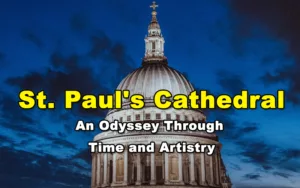Tower Bridge perched above the glistening currents of the River Thames, stands proud as a powerful testament to London’s deep-rooted history and architectural marvels. When you look across the cityscape, this grand edifice, with its iconic twin towers and sweeping walkways, embodies the heart of London’s rich past.
More than just a means to traverse the river, Tower Bridge showcases the city’s relentless passion for intertwining world-class engineering with everlasting elegance. Whether bathed in the gentle light of morning or illuminated by the sparkling lights of evening, Tower Bridge isn’t merely a structure—it’s the very essence of London’s spirit.
- Historical Background: Tower Bridge’s Journey Through Time
- Distinctive Features: Unravelling the Aesthetics and Engineering of Tower Bridge
- Engineering Marvel: The Science and Art Behind Tower Bridge
- Tower Bridge vs. London Bridge: Clearing the Confusion
- Cultural and Cinematic Significance: Tower Bridge in the Limelight
- Visiting Tower Bridge: A Guide to Exploring an Architectural Marvel
- Conservation Efforts: Safeguarding Tower Bridge for Future Generations
- Fun Facts: Unearthing Tower Bridge’s Lesser-Known Stories
- Tower Bridge FAQ
- Summing Up Tower Bridge
Historical Background: Tower Bridge’s Journey Through Time
As we delve into the annals of history, the tale of Tower Bridge’s inception and realization emerges as a fascinating blend of vision, engineering, and determination.
Timeline of its Construction:
- 1876: The necessity for a new bridge downstream from London Bridge became evident due to increased commercial development in the East End of London. A public competition was announced to design the new bridge.
- 1884: The winning design was chosen. Sir Horace Jones, the City Architect, in collaboration with John Wolfe Barry, proposed a bascule bridge.
- 1886: The monumental task of constructing Tower Bridge began. The purpose was clear: to ease road traffic while preserving the River Thames’ access to the busy docks.
- 1894: After eight gruelling years, Tower Bridge was officially opened by the Prince of Wales (later King Edward VII) and his wife, the Princess of Wales.
The Victorian Engineering Marvel:
In the late 1800s, technology was advancing at an unprecedented rate, and Tower Bridge stood as a shining example of the times. The designers faced a puzzle: how could they build a bridge without hindering the bustling ship movement below? Their brilliant answer was to craft a ‘bascule’ bridge, borrowing the term from the French word for “seesaw.” This innovative design meant the bridge could lift and lower, making way for even the grandest of ships to sail through.
Constructing the bridge was no easy task. Massive piers had to be sunk into the riverbed to support the construction. Over 11,000 tons of steel provided the bridge’s framework. Then, to harmonize with the nearby Tower of London, the framework was clad in Cornish granite and Portland stone.
However, challenges were rife. From dealing with the muddy Thames riverbed to ensuring that the busy waterway remained navigable throughout the construction, the project demanded unparalleled engineering acumen and perseverance.
The result? An iconic drawbridge that not only served its functional purpose but also stood as a testament to the audacious spirit of Victorian engineering.
Distinctive Features: Unravelling the Aesthetics and Engineering of Tower Bridge
One cannot simply appreciate Tower Bridge without diving deep into the distinctive features that make it so iconic. Each element tells a story of innovation, design, and the blending of function with art.
Dual Bascules and the Two Towers:
At the core of Tower Bridge is its signature element: the twin bascules. Think of them as two massive flaps that lift and drop, creating a path for ships below. Impressively, each of these giant flaps weighs around 1,000 tons and can tilt up to an angle of 86 degrees in mere minutes – a testament to the genius behind its engineering.
Standing guard beside these bascules are the two towering pillars, reaching up 65 meters over the Thames. These aren’t just structural beauties; they hold the machinery that moves the bascules and stand as grand entrances to the heart of London.
The High-Level Walkways and Panoramic Views:
Originally designed to allow pedestrians to cross the bridge even when the bascules were raised, the high-level walkways are positioned 42 meters above the river. Today, they offer an unparalleled vantage point. From here, one can soak in breath-taking panoramic views of the London skyline, with landmarks like The Shard, The Gherkin, and the historic Tower of London in clear sight. Modern additions, like the glass-floored sections, offer a thrilling perspective of the bustling bridge below and the river flowing underneath.
The Unique Blend of Architectural Styles:
Tower Bridge is a masterclass in combining architectural styles. Its Victorian Gothic design was chosen to harmonize with the nearby Tower of London. The ornate details, turrets, and pale blue and white colour scheme lend it a fairy-tale appearance. Yet, beneath this historical façade lies a robust steel skeleton, a nod to the Industrial Age’s might. This juxtaposition of the ancient and the modern, the ornate and the robust, gives Tower Bridge its distinct and unforgettable character.
Engineering Marvel: The Science and Art Behind Tower Bridge
Tower Bridge, beyond its aesthetic appeal, stands as a remarkable testament to the engineering prowess of its time. Its combination of beauty and function is underpinned by ground-breaking technologies and design choices that were ahead of their era.
The Mechanics Behind the Bascule (Lifting Mechanism):
The heart of Tower Bridge’s functionality lies in its bascule mechanism. A bascule, which draws its name from the French word for “seesaw,” operates on the principle of counterbalancing. Each of the two bascules has a heavy counterweight that assists in the raising and lowering process.
When ships need to pass, these counterweights sink down into vast chambers below the riverbed, pulling the bascules upward. This clever use of physics ensures that the massive leaves can be lifted with minimal energy, facilitating swift and efficient operation.
Incorporation of the Steam-Driven Engines and Transition to Modern Technologies:
Originally, the raising of the bascules was powered by steam-driven engines. These engines pumped water into hydraulic accumulators, which then released the stored energy to power the bridge lifts. The engine rooms, with their gleaming brass and intricately designed machinery, were a marvel of Victorian engineering.
However, as technology evolved, so did Tower Bridge. By 1976, the original steam-driven mechanisms were replaced by a more modern and efficient electro-hydraulic drive system. Despite this transition, the Victorian engine rooms have been preserved and are now part of the Tower Bridge Exhibition, offering a glimpse into the bridge’s industrious past.
Significance in Bridging Design and Construction:
Tower Bridge set a new standard in the world of bridge design. Its dual functionality – serving as both a suspension and a bascule bridge – was a solution tailored to the unique needs of its location. By addressing the challenges posed by a busy river route and the need for road connectivity, it paved the way for thinking outside the box in bridge design.
Furthermore, its successful integration of form and function has made it a case study in how aesthetic considerations can be harmoniously blended with engineering requirements. Tower Bridge remains a symbol of innovative design, inspiring future generations of architects and engineers worldwide.
Tower Bridge vs. London Bridge: Clearing the Confusion
It’s a frequent mix-up, often perpetuated by popular culture and even some well-meaning tourists: confusing Tower Bridge with London Bridge. The two structures, while in proximity, have very distinct histories, appearances, and purposes. Let’s untangle the web of confusion that sometimes surrounds these iconic bridges.
Brief History of London Bridge:
London Bridge has been a pivotal crossing over the River Thames since Roman times. In fact, there have been multiple iterations of London Bridge throughout history. The medieval version, which stood for over 600 years, was famously dotted with buildings and shops, creating a bustling urban thoroughfare. Perhaps most famously, it inspired the nursery rhyme “London Bridge is Falling Down.” The current London Bridge, a more functional and subdued design compared to its predecessors, was opened in 1973. It’s a workhorse of a bridge, primarily serving vehicular and pedestrian traffic.
Common Misconceptions Between the Two:
- Name Confusion: Many visitors mistakenly refer to Tower Bridge as London Bridge due to its grandeur and iconic status.
- Historical Events: Events or stories that took place on London Bridge, like the display of traitors’ heads on spikes in medieval times, are sometimes wrongly associated with Tower Bridge.
- Cinematic Mix-ups: Films and TV shows sometimes contribute to the confusion. A shot might show characters near Tower Bridge and reference London Bridge or vice-versa.
Key Distinguishing Features:
- Architectural Grandeur: Tower Bridge, with its two majestic towers, bascule mechanism, and high-level walkways, is undeniably more ornate and visually striking than its counterpart.
- Functionality: While both bridges accommodate road traffic and pedestrians, only Tower Bridge boasts a lifting mechanism to allow tall ships to pass.
- Location and Proximity to Landmarks: Tower Bridge is situated close to the Tower of London, while London Bridge lies further upstream, linking the City of London to Southwark.
In conclusion, while both bridges hold significant places in London’s history and urban landscape, they serve different stories and purposes. By understanding their distinct features and histories, one can truly appreciate the roles each plays in the tapestry of London’s riverside saga.
Cultural and Cinematic Significance: Tower Bridge in the Limelight
With its towering presence and architectural charm, Tower Bridge has captured the imagination of storytellers, filmmakers, and cultural enthusiasts for generations. Its iconic silhouette is instantly recognizable, making it a favourite backdrop for a myriad of creative works and historic events.
Tower Bridge in Popular Culture, Movies, and Television Shows:
1. Film: In the movie “Sherlock Holmes” (2009), directed by Guy Ritchie, Tower Bridge serves as a significant backdrop, especially during the climactic scenes where its incomplete state is depicted, considering the movie’s timeline.
2. Music: The bridge has been featured in numerous music videos, symbolizing the city of London. British bands, in particular, often use it as a familiar, evocative backdrop.
3. Literature: Tower Bridge often makes appearances in literature set in London, serving as a setting for romance, mystery, and historical fiction. Its rich history and aesthetic appeal make it a compelling backdrop for storytelling.
4. Television: Popular TV shows, especially those set in London, like “Doctor Who” and “EastEnders”, have showcased Tower Bridge in various episodes, utilizing its dramatic potential.
Iconic Events that Took Place at or Near the Bridge:
1. Bridge Openings: Throughout its history, the spectacle of Tower Bridge lifting its bascules for passing ships has always been an event, drawing crowds and photographers eager to catch a glimpse of engineering in action.
2. The 2012 Olympic Games: During the summer Olympics in London, Tower Bridge took centre stage. It was adorned with the Olympic Rings, and it became a symbol of the city’s hosting of the global event.
3. Spitfire Anniversary Flypast: Marking significant military anniversaries, aircraft, including the iconic Spitfire, have flown over the Thames with Tower Bridge serving as a dramatic backdrop.
4. The Double-Decker Bus Leap: In 1952, a bus was forced to leap between the bascules when the bridge began to rise with the bus still on it. The event, while alarming, ended without injuries and has since become a legendary tale associated with the bridge.
Be it as a backdrop for silver screen classics or the centre stage for real-world events and festivities, Tower Bridge remains a testament to London’s vibrant blend of history, culture, and creativity. Its legendary stature guarantees that it will keep sparking admiration and awe for many generations ahead.
Visiting Tower Bridge: A Guide to Exploring an Architectural Marvel
Setting foot on the timeless foundation of Tower Bridge feels like a magical journey, merging Victorian brilliance with today’s wonders. So, whether you’re an excited traveller, a history enthusiast, or just someone keen to soak in one of London’s standout sights, here’s the scoop you’ve been looking for.
The Tower Bridge Exhibition: What to Expect
- History and Mechanics: Venture into the engine rooms and discover the original steam engines that once powered the bridge lifts. Interactive displays and exhibits provide a deep dive into the bridge’s history and the engineering marvels behind its construction.
- Glass-Floored Walkway: Ascend to the high-level walkways and tread cautiously on the transparent glass floor. It offers a unique bird’s-eye view of the bridge and the river below—a thrilling experience not for the faint-hearted!
- Panoramic Views: The walkways provide breathtaking panoramic vistas of London’s skyline. Gaze upon the River Thames, The Shard, the Tower of London, and more from this privileged vantage point.
- Interactive Displays: Modern touch screens and videos throughout the exhibition cater to visitors of all ages, ensuring an educational and entertaining experience.
Tips for Visitors:
- Best Times to Visit: Early mornings or late afternoons tend to be less crowded. If you can, try to time your visit during a bridge lift to witness the bascules in action.
- Photography Spots: The high-level walkways are ideal for capturing the London skyline. For shots of the bridge itself, the nearby banks of the River Thames offer splendid angles.
- Guided Tours: Opt for a guided tour to gain deeper insights into the bridge’s history, mechanics, and stories. Expert guides often share lesser-known tidbits that enrich the experience.
- Comfortable Footwear: As you’ll be exploring and climbing staircases, ensure you wear comfortable shoes.
Nearby Attractions and Making the Most of Your Day:
- The Tower of London: Just a stone’s throw away, this historic fortress is home to the Crown Jewels and tells tales of royalty, ravens, and beheadings.
- St. Katharine Docks: A hidden gem, this marina is lined with shops, restaurants, and offers a tranquil escape from the city’s hustle and bustle.
- Shad Thames: Explore this historic riverside street with its cobbled lanes, warehouses, and array of dining options.
- HMS Belfast: Moored nearby, this Royal Navy cruiser, now a floating museum, offers a deep dive into naval history.
Make sure to allocate a full day if you’re keen to explore both Tower Bridge and its neighbouring attractions. With history, engineering, and beauty combined, it promises an enriching and unforgettable London experience.
Conservation Efforts: Safeguarding Tower Bridge for Future Generations
As a living testament to London’s history and engineering prowess, Tower Bridge’s continued existence isn’t merely about its functional utility but also about preserving a piece of the city’s soul. Ensuring its longevity, however, comes with a set of challenges and responsibilities that various entities tirelessly address.
Preservation and Maintenance Challenges:
1. Aging Infrastructure: Being over a century old, the bridge’s components naturally experience wear and tear. The challenge lies in restoring these parts without compromising the original design and integrity.
2. Modern Usage: The bridge was designed during the Victorian era, and the strain from contemporary traffic—both vehicular and pedestrian—poses risks that were not initially anticipated.
3. Environmental Factors: The River Thames’ tidal movements, pollution, and the ever-changing English weather can take a toll on the bridge’s materials, necessitating regular checks and interventions.
4. Balancing Act: While upgrades and repairs are crucial, they must be undertaken without altering the bridge’s historic appearance and character.
Role of Local Authorities and Heritage Groups:
1. Oversight and Funding: The City of London Corporation oversees the maintenance and operations of Tower Bridge. They allocate funds and ensure that the bridge meets both safety standards and heritage conservation requirements.
2. Regular Inspections: Expert teams routinely inspect the bridge, evaluating its structural integrity and identifying areas in need of repair or restoration.
3. Collaboration with Heritage Entities: Organizations like Historic England work in tandem with local authorities, offering guidance on preservation techniques that align with the bridge’s historical significance.
4. Public Engagement: Local officials and heritage organizations are hands-on in connecting with the community. They enlighten people about the bridge’s storied past and the crucial role of preserving it. This cultivates a shared sense of pride and duty among the community.
5. Conservation Research: Constant research is conducted to find innovative methods that can ensure the bridge’s longevity while adhering to its original design and materials. This might involve studying similar historical structures or leveraging modern technology in conservation.
In essence, the task of preserving Tower Bridge is a collaborative effort, blending the meticulous care of heritage conservation with the practicalities of modern engineering. As the bridge stands tall, it serves not only as a connection across the Thames but also as a symbol of how history and progress can coexist harmoniously.
Fun Facts: Unearthing Tower Bridge’s Lesser-Known Stories
Beyond its grand exterior and the popular stories of its origins, Tower Bridge holds a collection of unique stories, fun facts, and unforgettable events. Let’s dive deep and uncover some of these hidden treasures.
Interesting Tidbits and Lesser-Known Facts:
1. Animal Parade: When the bridge opened in 1894, authorities were concerned about how the bridge would stand up to the weight of heavy traffic. As a test, they led a parade of elephants across it!
2. Original Colour Scheme: The bridge hasn’t always sported its iconic blue and white hue. It was originally painted a chocolate brown colour. The current colours were chosen for Queen Elizabeth II’s Silver Jubilee in 1977.
3. Underwater Habitats: The piers of Tower Bridge house a variety of marine life, including seahorses, which have been found during surveys of the Thames.
4. A Royal Bypass: Legend has it that a secret passageway exists within the bridge, built for the sole use of the royal family to bypass public traffic. However, this remains a widely debated topic.
Noteworthy Events:
1. The Infamous Double-Decker Bus Jump: One of the most heart-stopping incidents on the bridge happened in 1952. A miscommunication caused the bridge to start lifting with a double-decker bus still on it. Thinking fast, the bus driver hit the gas, making a daring jump across the widening gap to reach the other side safely. Amazingly, no one was seriously hurt, and the quick-thinking driver was later honoured for his courageous act.
2. Flying Under Tower Bridge: In 1968, a Royal Air Force pilot named Alan Pollock flew a Hawker Hunter jet beneath the walkway of Tower Bridge as a spontaneous protest against the lack of aerial displays for the RAF’s 50th anniversary. While his flying skills were undoubtedly impressive, he was promptly arrested upon landing and his flying license was revoked.
These titbits, while not always at the forefront of the bridge’s mainstream narrative, add depth and colour to its rich tapestry of tales, reminding us that history is often a blend of the grand and the unexpected.
Tower Bridge FAQ
Q1: What is Tower Bridge?
A: Tower Bridge is a combined bascule and suspension bridge that spans the River Thames in London. It’s an iconic symbol of the city and stands adjacent to the Tower of London.
Q2: When was Tower Bridge built?
A: Construction of Tower Bridge started in 1886 and was completed in 1894.
Q3: Why was Tower Bridge built?
A: The bridge was built to ease road traffic congestion while preserving the River Thames’ access to the busy docks of East London.
Q4: Can you walk across Tower Bridge?
A: Yes, pedestrians can walk across Tower Bridge. There are also high-level walkways that offer panoramic views of the city, which are part of the Tower Bridge Exhibition.
Q5: How often does the bridge lift, and can the public view it?
A: Tower Bridge lifts around 800 times a year. The lifting times are available on the official Tower Bridge website, and the public can indeed view this spectacle from either side of the river.
Q6: What’s the difference between Tower Bridge and London Bridge?
A: Tower Bridge is often confused with London Bridge due to their proximity. However, London Bridge is a more functional and simpler bridge upstream from Tower Bridge. Tower Bridge, on the other hand, is distinguished by its twin towers and lifting mechanism.
Q7: Can I visit the inside of Tower Bridge?
A: Yes, the Tower Bridge Exhibition allows visitors to explore the history, engineering, and panoramic views from the high-level walkways. The exhibition also includes a visit to the Victorian Engine Rooms.
Q8: How long does it take to tour the Tower Bridge Exhibition?
A: A typical visit to the Tower Bridge Exhibition lasts about 1 to 2 hours.
Q9: Has Tower Bridge ever had any accidents or mishaps?
A: One of the most famous incidents was in 1952 when a double-decker bus had to jump a small gap when the bridge began lifting while the bus was still on it.
Q10: Is Tower Bridge wheelchair accessible?
A: Yes, Tower Bridge is fully accessible to everyone, including those using wheelchairs or with other mobility needs.
Q11: How can I get to Tower Bridge?
A: Tower Bridge is accessible via several modes of transport, including the London Underground (nearest station: Tower Hill), buses, and river services. Walking and cycling are also popular options for reaching the bridge.
Q12: Are there any special events or exhibitions at Tower Bridge?
A: Tower Bridge frequently holds unique exhibitions and activities, particularly in the Engine Rooms and its pathways. Visit the official Tower Bridge website to stay updated on upcoming events and current status.
Summing Up Tower Bridge
As we’ve journeyed through the annals of time, one truth emerges undeniably: Tower Bridge is not just a structure of stone and steel. It’s a testament to human ambition, an emblem of London’s enduring spirit, and a beacon that has, for over a century, gracefully bridged the past with the present.
From its early days, crafted to link a thriving city, to its iconic stature in modern culture and film, Tower Bridge rises, reflecting the aspirations and zeal of its creators. Its perfect melding of Victorian sophistication with sturdy engineering doesn’t just highlight design wonders but also the evergreen spirit of innovation. More than its silhouette in London’s horizon, it embodies narratives – of daily lives, victories, and those unforgettable moments woven into the city’s tapestry.
So, if you’re a lover of history, an admirer of architecture, or just someone yearning to feel the heartbeat of London, Tower Bridge invites you. Walk its history-laden lanes, drink in the city views from its vistas, and let its stories move you. If a visit isn’t on the cards just yet, dive into its rich history, delve deeper into its stories, and let its enduring spirit showcase the marvels birthed when dreams meet grit. Tower Bridge isn’t merely a crossing; it’s a vivid chapter in London’s grand tale, awaiting your exploration.
“I may earn commissions as an affiliate from sponsored links within this post”








